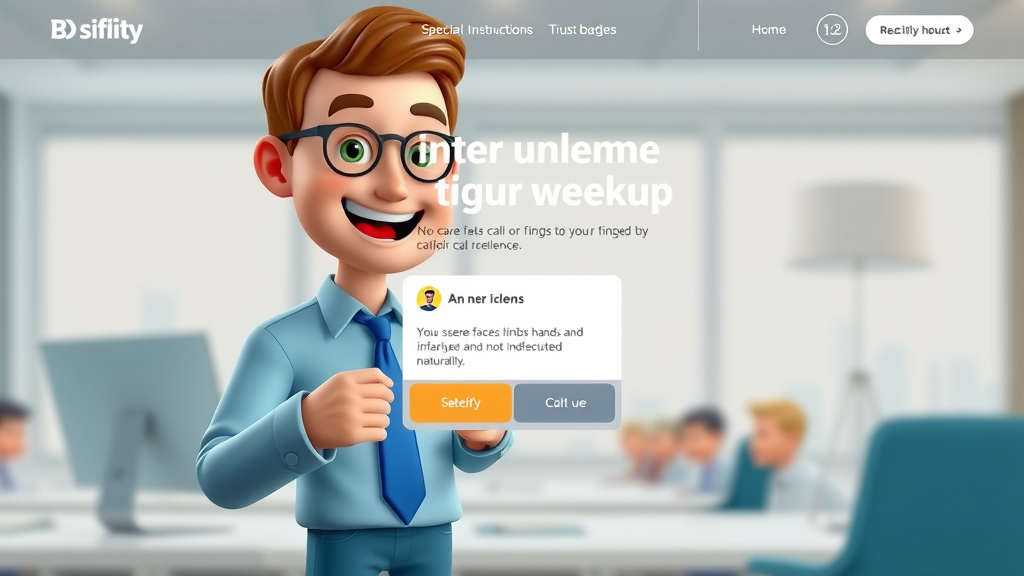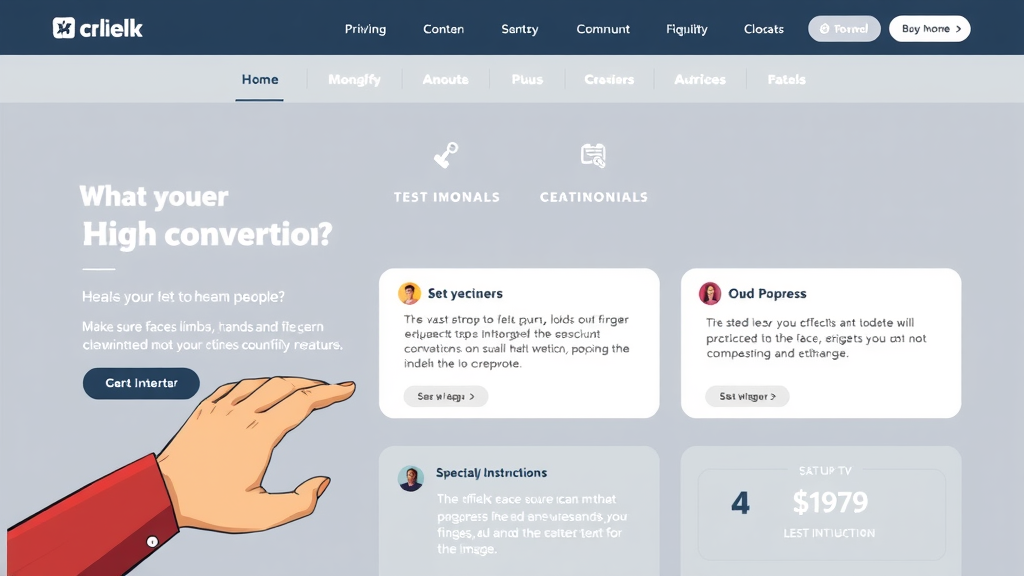Did you know that even just a 1% improvement in your website’s conversion rate can double your revenue without attracting a single new visitor? In today’s digital marketplace, conversion rate optimization (CRO) isn’t reserved for massive brands or tech whizzes. Instead, it’s a powerful yet accessible approach that lets every business unlock hidden value already flowing through its website. In this definitive guide, you’ll discover how small, strategic tweaks can financially transform your results—fast. Keep reading to uncover the secrets behind conversion rates , practical fixes you can make today, and proven strategies for long-term growth.
Unlocking Business Potential: How Conversion Rate Optimization Transforms Outcomes
Conversion rate optimization isn’t just about shifting buttons or changing colors on your site—it’s about reimagining your entire digital marketing approach to achieve dramatic gains with the traffic you already have. Most business owners focus on getting more visitors but neglect the big wins available from better serving those visitors. Consider this: if your site gets 10,000 visitors a month and your conversion rate rises from 2% to 3%, that’s an extra 100 sales or leads each month —without spending more on ads.
The impact is transformative. Companies that implement a CRO strategy typically see improved lead generation, higher customer satisfaction, and better ROI across all their digital channels. Whether your goal is e-commerce sales, B2B lead generation, or SaaS signups, conversion rate optimization empowers you to make more from every click. Focusing on conversion rates means working smarter, not harder , making CRO a top priority for businesses ready to scale.

Surprising Truth: The Average Conversion Rate Revealed
You might be surprised that the average conversion rate for websites across all industries typically sits between 2% and 5%. That means out of every 100 visitors, only 2 to 5 take the desired action such as making a purchase, filling out a form, or signing up for a newsletter . For many businesses, that leaves a staggering 95 to 98 site visitors slipping away without converting .
Achieving above-average conversion rates requires understanding every step of your customer’s journey and removing friction at each touchpoint. Leading performers in industries like e-commerce and SaaS often achieve conversion rates of 7% or higher by strategically optimizing product pages, landing pages, and checkout flows, underlining the power of focused conversion rate optimization efforts.
Why Every Website Needs a Conversion Rate Optimization Plan
If your business relies on its website to connect with customers, CRO is a must-have . With paid advertising costs rising and organic digital marketing becoming more competitive, squeezing more value from your current visitors is simply smart business. A solid CRO plan ensures your website visitors enjoy a seamless user experience, trust your brand, and are encouraged to take action.
Whether you manage a corporate site, e-commerce store, or lead generation landing pages, an ongoing conversion rate optimization strategy turns your website into a true revenue machine. Investing in CRO helps capture missed opportunities, lowers customer acquisition costs, and maximizes every marketing dollar you spend.
- The fundamentals of conversion rate optimization
- The difference between CRO and SEO
- Proven strategies to optimize your conversion rate
- How to assess and track conversion rate improvements
- Essential tools and tests for smarter conversion optimization
- Actionable tips for faster wins on landing pages, product pages, and more
Understanding the Basics of Conversion Rate Optimization
Before diving into advanced tactics, it’s crucial to understand the core principles behind conversion rate optimization . At its heart, CRO is about increasing the percentage of site visitors who complete a desired action—be it subscribing, purchasing, or engaging with your brand in a meaningful way. Unlike simply improving traffic, CRO empowers you to maximize the results from your existing audience.
This discipline blends elements of psychology, design, and data analysis to create an irresistible user experience that compels action. It requires a systematic approach—by identifying bottlenecks, testing hypotheses, and implementing continual improvements, you can reliably increase conversion rates and drive sustained business growth.
What is Conversion Rate Optimization and Why Does It Matter?
Conversion rate optimization is the deliberate process of improving your digital properties so that a greater percentage of website visitors convert. Conversions occur when a visitor completes a desired action —from making a purchase on a product page to submitting a lead form on a landing page .
This matters because drawing traffic requires budget and effort, while improving conversion rates leverages your existing investments for higher ROI. Top brands dedicate teams to rate optimization , but even small businesses can see significant results by applying basic CRO strategies—meaning every site owner stands to benefit.
Key Terms: Conversion Rate, Conversion Optimization, and Rate Optimization Explained
| Term | Definition |
|---|---|
| Conversion Rate | Percentage of visitors completing a desired action |
| Conversion Rate Optimization (CRO) | Systematic process to increase conversions |
| Conversion Optimization | Enhancing elements to boost conversion rate |
| Rate Optimization | Techniques to improve desired metric rates |
"Even a small lift in conversion rate can yield outsized business results."
How to Calculate Your Conversion Rate: A Step-by-Step Guide
Calculating your conversion rate is simple but essential. Start by identifying your total number of conversions —for example, purchases or lead form submissions—over a specific period. Next, divide this by the total number of visitors to your site or page, then multiply by 100 to get a percentage:
Conversion Rate (%) = (Number of Conversions ÷ Number of Visitors) × 100
If you had 150 conversions from 5,000 visitors, your rate is (150/5000) × 100 = 3%. Many leading analytics tools can automate this calculation and help you track different types of conversions, from purchases to newsletter signups, making it easier to monitor progress and spot new opportunities for improvement.

The Science Behind Conversion Rate Optimization
At its core, conversion rate optimization combines data analysis , experimentation, and user psychology. Every improvement is anchored in hard numbers—by studying how site visitors interact with your web pages , you can uncover friction points and opportunities for uplift. This scientific approach separates effective CRO from guesswork and random redesigns.
True improvements come from following a proven system: gather data, hypothesize changes, run controlled tests, and measure outcomes. Adopting this experimental mindset lets you iterate with confidence, reliably improving conversion rates over time.
How Does Conversion Rate Optimization Work?
Conversion rate optimization works by continually analyzing how visitors interact with your website and applying targeted changes to increase conversions. Typically, this starts with analytics tools and heatmaps to identify weak spots. From there, site owners develop hypotheses—like changing button color, simplifying forms, or updating copy—and test those updates through A/B testing (also called a CRO test ).
The process is both creative and methodical: you design experiments, launch them, then measure which version best helps users complete a desired action . The iterative cycle of optimization and learning helps take the guesswork out of improvement and turn your web page into a conversion optimization powerhouse.
Key Principles: Data, Testing, and User Experience
Successful CRO is built on three key pillars:
- Data: Use quantitative and qualitative data to drive decisions, not assumptions. Tools like Google Analytics, heatmaps, and user surveys are essential.
- Testing: A/B testing, multivariate testing, and controlled experiments let you tell what truly moves the needle.
- User Experience: User experience design is critical—a seamless journey makes it easy for visitors to convert.

Measuring Success: Understanding the Average Conversion Rate in Your Industry
Every industry benchmarks conversion rates differently. For instance, while an e-commerce store may average 2-3%, some SaaS companies target 4-7%. Knowing your industry’s average conversion rate helps set realistic goals and track meaningful progress. Don’t get discouraged by small starting numbers—a rigorous rate optimization process can rapidly bring you above industry norms.
Use analytics tools and published studies to compare your performance with sector standards. This context helps you justify investments and prove conversion rate improvements to stakeholders, reinforcing the value of your CRO efforts.
Aligning CRO Strategy with Business Goals
Your CRO strategy should be tailored to your business’s unique objectives and user journeys. For a retailer, boosting the number of “add to cart” actions may be highest priority, while a SaaS provider might focus on free trial signups. Align rate optimization projects with the biggest revenue drivers and desired actions to maximize returns.
Regularly revisiting your business goals can help sharpen your testing priorities and ensure conversion optimization remains integrated with your larger digital marketing strategy.
Quick Wins: Conversion Rate Optimization Fixes You Can Apply Today
Not every improvement requires months of planning or complex coding. You can boost conversion rates immediately by targeting high-impact fixes. These quick wins address common friction points on your landing pages , product pages , and checkout flows, helping capture low-hanging fruit for faster growth.
Here’s where to start for an instant uplift:
Optimizing the Landing Page for Higher Conversion Rate
- Compelling headlines
- Clear calls to action
- Simple, intuitive navigation
- Trust signals and social proof
A high-performing landing page zeroes in on solving the visitor’s problem and providing a clear path to the next step. Crafting a bold headline that taps into your audience’s motivation, combined with a strong call to action, can dramatically boost conversion . Intuitive navigation reduces confusion, while trust signals—like security badges, privacy policies, and client testimonials—instantly increase credibility and make it easier for users to act.

Product Page Tweaks to Improve Conversion Rate
Your product pages are the final decision point for many potential customers. Clarity is crucial: highlight product benefits, show high-quality images, and embed social proof through customer reviews. Offering multiple payment and shipping options reduces barriers to purchase, while concise, persuasive copy keeps attention focused on the desired action .
Don’t forget trust elements like return policies, guarantees, and secure checkout icons—these simple rate optimization tweaks remove uncertainty and can increase conversion percentage right away.
Boosting Conversion Rate with Social Proof and Trust Elements
Social proof is one of the most powerful psychological drivers in conversion optimization . Showcasing recent purchases, customer testimonials, ratings, and real-time activity gives hesitant visitors the nudge they need.
Integrating social proof widgets, review highlights, and third-party trust badges throughout your site builds instant credibility, which often results in a 10-15% uptick in conversion rates —especially on high-value product pages and sign-up flows.

User Experience (UX) Fixes that Deliver a Conversion Rate Uplift
Small improvements in user experience can yield major rate optimization benefits. Simplifying site navigation, streamlining forms, and eliminating page load delays minimize friction. Every extra field, step, or distraction increases the likelihood of visitors abandoning the process.
Use A/B testing to find the optimal design, button color, or call-to-action placement. Often, making your site feel easy, fast, and instinctive to use is the fastest path to higher conversion rates .
"Improving your site’s user experience isn’t just a best practice—it's a conversion optimization necessity."
| Test | Purpose | Typical Impact |
|---|---|---|
| Button Color | Increase CTA visibility | 5-10% lift |
| Social Proof | Build trust and credibility | 10-15% improvement |
| Simplified Forms | Reduce friction | 15-30% lift |

Comprehensive Conversion Rate Optimization Strategies for Sustained Growth
Once you’ve nailed the quick wins, it’s time to implement a long-term CRO strategy . Sustained growth comes from data-driven analysis, continuous testing, and a commitment to optimizing every phase of your user journey—not just single pages.
Here’s how advanced businesses maximize conversion rates at scale:
Data-Driven CRO Strategy: How to Analyze User Behavior
Harness analytics tools like Google Analytics and Hotjar to reveal how your visitors interact with each web page . Look for drop-off points, unexpected clicks, and repeated behaviors that indicate confusion or friction.
Heatmaps and session recordings transform raw data into actionable insight, guiding targeted rate optimization projects on your key pages. Let real user data, not opinions, prioritize your next move.

A/B Testing and CRO Tests: Taking the Guesswork Out of Conversion Optimization
A/B testing—also known as a CRO test —compares two or more versions of a page or element to identify which delivers the best results. By splitting your site visitors between variations, you can prove conversion improvements with statistical confidence.
From headline tweaks to complex workflow changes, every serious conversion optimization strategy includes regular testing and iterations. This approach not only increases conversions but also builds organizational knowledge about what works with your target audience.
Building a High-Converting Web Page: Rate Optimization Best Practices
A high-converting web page makes the desired action obvious and irresistible. Here’s what top-performing pages include:
- Laser-focused messaging that matches the user’s intent
- Strong, visually-distinct call-to-actions
- Trust signals (reviews, certifications, social proof)
- Fast load times and mobile-optimized design
- Clear value proposition above the fold

Maximizing Conversion Rate With Mobile Optimization
With over half of web traffic coming from smartphones or tablets, mobile conversion optimization is essential. Responsive designs, lightning-fast load times, and thumb-friendly navigation keep mobile visitors engaged and ready to convert.
Optimize forms for small screens, prioritize core content, and use persistent calls-to-action. Even modest efforts to improve mobile usability can create significant rate optimization wins.

Personalization and Segmentation to Improve Conversion Rate
Boost conversion rates by tailoring content, offers, and messaging to specific audiences. Use visitor data—such as location, device, or on-site behavior—to create hyper-relevant journeys that drive higher engagement and conversions.
Segmenting users allows you to address unique pain points and motivations, effectively increasing the number of conversions from your existing traffic base.
- Google Analytics
- Hotjar
- Optimizely
- Unbounce
People Also Ask
What is conversion rate optimization?
Conversion rate optimization (CRO) is the systematic process of increasing the percentage of website visitors who complete a desired action, such as filling out a form, making a purchase, or signing up for a service. It combines data analysis, user experience design, and testing to enhance a site’s ability to convert traffic into valuable outcomes.
How to optimize conversion rate?
To optimize conversion rate, start with analyzing your website data to identify underperforming areas. Implement changes to landing pages, calls to action, site speed, and trust elements. Continuously test and refine these elements using A/B or multivariate testing while monitoring improvements in your conversion metrics.
What is the difference between SEO and CRO?
SEO (Search Engine Optimization) focuses on increasing the quantity and quality of website visitors from organic search, while CRO (Conversion Rate Optimization) aims to increase the percentage of visitors who take a desired action once they visit the site. Both disciplines work hand-in-hand to drive sustainable business growth.
Is conversion rate optimization worth it?
Yes, conversion rate optimization is highly worthwhile. Even small increases in your conversion rate can produce significant results for your business, reducing costs per acquisition and maximizing revenue from your existing traffic without the need for more ad spend.
Proven Tips to Improve Conversion Rate on Any Website
- Clarify your value proposition on every page
- Streamline forms to the essentials
- Use strong, action-oriented call to actions
- Employ real-time social proof notifications
- Leverage heatmaps to understand visitor behavior
- Optimize for mobile responsiveness
- Test and iterate constantly
- Invest in great content and visuals
- Add customer reviews and trust badges
- Focus on site speed and usability
How Conversion Rate Optimization Fits Into Your Digital Marketing Strategy
Modern digital marketing is about synergy, not silos. While SEO attracts website visitors and content marketing builds trust, only conversion rate optimization ensures you maximize profit from all that energy. Integrating CRO across your channels gives you higher ROI and more resilient growth, especially as acquisition costs rise.
The most effective brands now treat CRO as core to their full-funnel marketing strategy, using it to prove conversion rate gains and justify budgets with real, measurable results.
Synergizing Conversion Rate Optimization and SEO
CRO and SEO are natural partners. SEO increases qualified traffic, while CRO turns those visitors into customers or leads. By targeting shared metrics (like improved engagement and lower bounce rates), both disciplines fuel overall business success.
When your pages are both findable (SEO) and optimized for action (CRO), you achieve the maximum impact from your digital marketing investments.
Integrating CRO into the Overall Digital Marketing Funnel
Conversion optimization doesn’t stop at one page—it aligns closely with your full funnel. Map out user journeys from first touch through to final sale, and identify opportunities for improvement at each stage. From awareness ads and blog posts to retargeting and onboarding, apply CRO thinking across your funnel for end-to-end uplift.
A comprehensive funnel approach ensures no website visitor is left behind and every click is maximized for value.
Tracking KPIs: Prove Conversion Rate Gains to Stakeholders
To justify resources and demonstrate results, you’ll need to prove conversion rate improvements. Focus on KPIs such as conversion rate , average order value, revenue per visitor, and lead quality. Dashboards and regular reporting help share wins with management and create momentum for further optimizations.
Case Studies: Conversion Rate Optimization Success Stories
Real-world examples show just how game-changing effective conversion optimization can be. Here are some typical results after launching a targeted CRO strategy :
| Business Type | Initial Conversion Rate | After CRO | Revenue Impact |
|---|---|---|---|
| E-commerce | 1.5% | 2.4% | +28% |
| SaaS | 2.0% | 3.1% | +44% |
| Services | 1.2% | 2.7% | +64% |

"A targeted CRO test paid for itself within three months—and then kept on delivering."
Choosing the Best CRO Strategy for Your Website Visitors
The most powerful CRO strategies are tailored, not one-size-fits-all. Identify the unique pain points, goals, and behaviors of key segments within your site visitors group, then customize your approach for maximum resonance and results.
By mapping personalized journeys and addressing specific needs—such as first-time vs. returning users—you can capture more conversions across your full web page portfolio.
Customizing Conversion Rate Optimization for Different User Journeys
Every visitor travels a different path through your website. Leverage analytics and user feedback to uncover these journeys. For example, new visitors often need more trust signals, while returning customers respond well to faster checkouts and loyalty rewards.
Segmenting your audience and aligning conversion optimization tactics—such as targeted offers, retargeting, or dynamic content—ensures every group gets exactly what it needs to convert.
When to Use CRO Testing vs. Full Redesigns
Small, iterative CRO tests offer rapid results and are perfect for minor fixes or specific bottlenecks. Save full redesigns for when your data shows consistent underperformance across the entire site, or when a shift in your business model warrants an overhaul.
Run A/B tests routinely to spot quick wins, but keep an eye on the big picture to ensure you’re not missing deeper structural opportunities for upsizing conversion rates .
Frequently Asked Questions About Conversion Rate Optimization
What is the typical timeline to see conversion rate improvements?
Many businesses notice improvements within a few weeks of making targeted changes. However, for statistically significant results—especially on low-traffic sites—allow up to 2-3 months of testing and iteration. Continual optimization delivers compounding benefits over time.
How much traffic do I need for effective rate optimization?
While more traffic leads to faster CRO tests, even small businesses can run meaningful experiments. Aim for at least several hundred visitors per variation to get reliable results. Tools can estimate how long your tests should run based on your average traffic and target uplift.
Can conversion rate optimization impact my SEO rankings?
Absolutely. Improving user experience , decreasing bounce rates, and speeding up page loads all support better rankings in search results—making CRO and SEO mutually reinforcing disciplines.
How often should I run A/B tests on my web page?
Consistent A/B testing is ideal. As a rule of thumb, run new tests anytime you launch an update, see drop-offs, or have enough traffic to support statistically valid comparisons. Ongoing tests ensure you’re always learning and optimizing.
Watch our quick explainer for a visual walkthrough of CRO fundamentals and actionable tips to get started fast.
See how experts diagnose conversion bottlenecks on real websites in a hands-on, interactive screen share demo.
Take a guided tour of the industry’s best CRO tools—from data analysis to A/B testing—to accelerate your own optimization journey.
Boost Your Results: Next Steps for Conversion Rate Optimization
Key Takeaways for Applying Conversion Rate Optimization to Your Website
- Assess your website’s current conversion rates
- Prioritize quick wins and high-impact changes
- Commit to regular CRO testing and iteration
- Leverage industry benchmarks and proven tactics
- Seek expert support if you’re not seeing desired results
Get Expert Guidance to Maximize Your Conversion Rate Optimization Results
Work With Proven CRO Specialists for Immediate Impact
If you’re ready to skip the learning curve and get expert-driven, immediate improvements, it’s time to partner with professionals. Proven CRO specialists bring a toolkit of tactics, tech, and experience that can dramatically increase your results in just weeks.
Contact Us for a Personalized Conversion Rate Optimization Audit
"Don’t let another visitor slip away—unlock your site’s true potential through expert conversion rate optimization."
Interested in learning exactly how your website can perform better? Contact us for a personalized audit and actionable roadmap tailored to your goals.
Ready to Increase Conversion Rate? Call Us Today!
Call us at (385) 469-1869 or email at info@solu4u.com today!
Conclusion
Act now: assess your current performance, apply high-impact fixes, and commit to continuous testing for measurable conversion rate improvements.
Sources
- https://www.optimizely.com/optimization-glossary/conversion-rate-optimization/
- https://www.crazyegg.com/conversion-rate-optimization/
- https://neilpatel.com/what-is-conversion-rate-optimization/
To further enhance your understanding of conversion rate optimization (CRO), consider exploring the following authoritative resources:
- “Conversion Rate Optimization: 17 High-Impact Strategies” ( wordstream.com )
This article provides actionable strategies to improve your website’s conversion rates, including tips on page load speed, mobile optimization, and effective call-to-action designs.
- “Conversion Rate Optimization (CRO): Definition & Best Practices” ( forbes.com )
This resource offers a comprehensive overview of CRO, detailing its importance and best practices, such as removing distractions, improving page load speed, and learning from high-converting content.
By delving into these resources, you’ll gain valuable insights and practical techniques to effectively optimize your website’s conversion rates.
 Add Row
Add Row  Add
Add 




Write A Comment